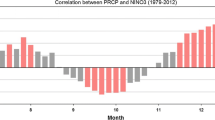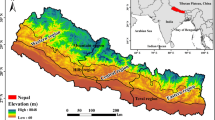Abstract
In this study, winter precipitation variability associated with the El Niño-Southern Oscillation (ENSO) over the Korean Peninsula was investigated using a 5-pentad running mean data because significant correlation pattern cannot be revealed using seasonal-mean data. It was found a considerably significant positive correlation between Niño3 sea-surface temperature and precipitation during early winter (from Mid-November to early-December), when the correlation coefficient is close to 0.8 in early-December; the correlation is distinctively weakened during late winter. It is demonstrated that such sudden intraseasonal change in relation to ENSO is associated with the presence of anticyclonic flow over the Kuroshio extension region (Kuroshio anticyclone). In early winter, there is strong southerly wind over the Korean Peninsula, which is induced by the Philippine Sea anticyclone and Kuroshio anticyclone. However, in January, although the Philippine Sea anticyclone develops further, the Kuroshio anticyclone suddenly disappears; as a result, the impact of ENSO is considerably weakened over the Korean Peninsula. These results indicate that the Kuroshio anticyclone during El Niño peak phase plays a critical role by strongly affecting Northeast Asia climate, including the Korean Peninsula. In addition, it is also found that there are distinctive interdecadal changes of the relationship between ENSO and precipitation over the Korean Peninsula. In particular, the strong correlation in early winter is clearer in the recent 30 years than that in the previous period of 1950–1979.












Similar content being viewed by others
References
Ahn JB, Ryu J-H, Cho E-H, Park J-Y, Ryoo S-B (1997) A Study on correlation between air-temperature and precipitation in Korea and SST over the Tropical Pacific. J Korean Meteorol Soc 33:487–495 (in Korean with English abstract)
An S-I (2004) Interdecadal changes in the El Niño-La Niña asymmetry. Geophy Res Lett 31:L23210
An S-I, Choi J (2009) Seasonal locking of the ENSO asymmetry and its influence on the seasonal cycle of the tropical eastern Pacific sea surface temperature. Atmos Res 94:3–9
An S-I, Jin F–F (2001) Collective role of thermocline and zonal advective feedbacks in the ENSO mode. J Clim 14:3421–3432
An S-I, Wang B (2000) Interdecadal change of the structure of the ENSO mode and its impact on the ENSO frequency. J Clim 13:2044–2055
An S-I, Wang B (2001) Mechanisms of locking the El Niño and La Niña mature phases to boreal winter. J Clim 27:2164–2176
Blade I, Newman M, Alexander MA, Scott JD (2008) The late fall extratropical response to ENSO: sensitivity to coupling and convection in the tropical West Pacific. J Clim 21:6101–6118
Cha E-J, Jhun J-G, Chung H-S (1999) A study of characteristics of climate in South Korea for El Niño/La Niña year. J Korean Meteorol Soc 35:98–117 (in Korean with English abstract)
Fu C, Teng X (1988) The relationship between ENSO and climate anomaly in China during the summer time. Sci Atmos Sin 12:133–141
Galanti E, Tziperman E (2000) ENSO’s phase locking to the seasonal cycle in the fast-SST, fast-wave, and mixed-mode regimes. J Atmos Sci 57:2936–2950
Gershunov A, Barnett TP (1998) Interdecadal modulation of ENSO teleconnections. Bull Am Meteorol Soc 79:2715–2725
Gill AE (1980) Some simple solutions for heat-induced tropical circulations. Q J R Meteorol Soc 106:447–462
Gong D-Y, Ho C-H (2002) Shift in the summer rainfall over the Tangtze River valley in the late 1970s. Geophys Res Lett 29:1463. doi:10.1029/2001GL014523
Graham NE (1994) Decadal-scale climate variability in the tropical and North Pacific during the 1970s and 1980s: observations and model results. Clim Dyn 10:135–162
Gu D, Philander SGH (1997) Interdecadal climate fluctuation that depend on exchanges between the tropics and extratropics. Science 275:805–807
Ha K-J, Lee S–S, Vinayachandran PN, Jhun J-G (2008) Changma and shifting peak in summer rainfall of Korea: ENSO influence. Adv Geosci 16:35–46
Ham Y-G, Kug J-S, Kim D, Kim Y-H, Kim D-H (2012) What controls phase locking of ENSO to boreal winter in coupled GCMs? Clim Dyn. doi:10.1007/s00382-012-1420-2
Ho C-H, Lee J-Y, Ahn M-H, Lee H-S (2003) A sudden change in summer rainfall characteristics in Korea during the late 1970s. Int J Climatol 23:117–128. doi:10.1002/joc.864
Horel JD, Wallace JM (1981) Planetary scale atmospheric phenomena associated with the Southern Oscillation. Mon Weather Rev 125:773–788
Hoskins BJ, Karoly DJ (1981) The steady linear response of a spherical atmosphere to thermal and orographic forcing. J Atmos Sci 38:1179–1196
Huang R, Wu Y (1989) The influence of ENSO on the summer climate change in China and its mechanism. Adv Atmos Sci 6:21–32
Huang R, Chen W, Yang B, Zhang R (2004) Recent advances in studies of the interaction between the East Asian winter and summer monsoons and ENSO cycle. Adv Atmos Sci 21:407–424
Intergovernmental Oceanographic Commission (1992) Oceanic interdecadal climate variability. IOC technical series, 40, UNESCO
Kalnay E et al (1996) The NCEP/NCAR 40-year reanalysis project. Bull Am Meteorol Soc 77:437–471
Kang I-S (1998) Relationship between El Niño and climate variation over Korea peninsula. J Korean Meteorol Soc 34:390–396 (in Korean with English abstract)
Kang I-S, Held IM (1986) Linear and nonlinear diagnostic models of stationary eddies in the upper troposphere during northern summer. J Atmos Sci 43:3045–3057
Karoly DJ, Hoskins BJ (1982) Three dimensional propagation of planetary waves. J Meteorol Soc Jpn 60:109–123
Kerr RA (1992) Unmasking a shifty climate system. Science 255:1508–1510
Kug J-S, Kang I-S (2006) Interactive feedback between the Indian Ocean and ENSO. J Clim 19:1784–1801
Kug J-S, Kirtman BP, Kang I-S (2006a) Interactive feedback between ENSO and the Indian Ocean in an interactive ensemble coupled model. Am Meteorol Soc 19:6371–6381
Kug J-S, Li T, An S-I, Kang I-S, Luo J–J, Masson S, Yamagata T (2006b) Role of the ENSO-Indian Ocean coupling on ENSO variability in a coupled GCM. Geophys Res Lett 33:L09710. doi:10.1029/2005GL024916
Kug J-S, Jin F–F, An S-I (2009) Two types of El Niño events: cold tongue El Niño and warm pool El Niño. J Clim 22:1499–1515
Kug J-S, Ahn M-S, Sung M-K, Yeh S-W, Min H-S, Kim Y-H (2010a) Statistical relationship between two types of El Niño events and climate variation over the Korean Peninsula. Asia Pac J Atmos Sci 46(4):467–474
Kug J-S, Jin F–F, Park J, Ren H-L, Kang I-S (2010b) A general rule for synoptic-eddy feedback onto low-frequency flow. Clim Dyn 35:1011–1026. doi:10.1007/s00382-009-0606-8
Lau NC (1985) Modeling the seasonal dependence of the atmospheric response to observed El Niños in 1962–1976. Mon Weather Rev 113:1970–1996
Lau KM, Weng H (1999) Interannual, decadal-interdecadal and global warming signals in sea surface temperature during 1955–97. J Clim 12:1257–1267
Lau KM, Weng H (2001) Coherent modes of global SST and summer rainfall over China: an assessment of the regional impacts of the 1997–98 El Niño. J Clim 14:1294–1308
Lee S–S, Vinayachandran PN, Ha K-J, Jhun J-G (2010) Shift of peak in summer monsoon rainfall over Korea and its association with El Niño-Southern Oscillation. J Geophys Res 115:D02111. doi:10.1029/2009JD011717
Lee S-S, Lee J-Y, Wang B, Ha K-J, Heo K-Y, Jin F-F, David MS, Shukla J (2011) Interdecadal changes in the storm track activity over the North Pacific and North Atlantic. Clim Dyn. doi:10.1007/s00382-011-1188-9
Lin JL (2007) Interdecadal variability of ENSO in 21 IPCC AR4 coupled GCMs. Geophys Res Lett 34:L12702. doi:10.1029/2006GL028937
Livezey RE, Mo KC (1987) Tropical-extratropical teleconnections during the northern hemisphere winter. Part II: relationships between monthly mean northern hemisphere circulation patterns and proxies for tropical convection. Mon Weather Rev 115:3115–3132
Moron V, Gouirand I (2003) Seasonal modulation of the El Niño-Southern Oscillation relationship with sea level pressure anomalies over the north Atlantic in October–March 1873–1996. Int J Climatol 23:143–155
Nicholls N, Lavery B, Frederiksen C, Drodowsky W (1996) Recent apparent changes in relationships between the El Niño-Southern Oscillation and Australian rainfall and temperature. Geophys Res Lett 23:3357–3360
Qien W, Kang H-S, Lee D-K (2002) Distribution of seasonal rainfall in the East Asian monsoon region. Theor Appl Climatol 73:151–168. doi:10.1007/s00704-002-0679-3
Rasmusson EM, Carpenter TH (1982) Variations in tropical sea surface temperature and surface wind fields associated with the Southern Oscillation/El Niño. Mon Weather Rev 110:354–384
Smith TM, Reynolds RW, Peterson TC, Lawrimore J (2008) Improvements to NOAA’s historical merged land-ocean surface temperature analysis (1880–2006). J Clim 21:2283–2296
Strutt JW (Lord Rayleigh) (1890) On bells. Philos Mag 29: 1–17
Tao SY, Chen LX (1987) A review of recent research of the East Asian summer monsoon in China. Monsoon Meteorol Monogr Geol Geophys, Vol. 7. Oxford University Press, pp 60–92
Wang B (1995) Interdecadal changes in El Niño onset in the last four decades. J Clim 8:267–285
Wang B, Chan JCL (2001) How strong ENSO events affect tropical storm activity over the western north Pacific. J Clim 15:1643–1658
Wang H, Fu R (2000) Winter monthly mean atmospheric anomalies over the North Pacific and North America associated with El Niño SSTs. Am Meteorol Soc 13:3435–3447
Wang B, Ho L (2002) Rainy season of the Asian-Pacific summer monsoon. J Clim 15:386–398. doi:10.1175/1520-0442(2002)015<0386:RSOTAP>2.0.CO;2
Wang B, Wu R, Fu X (2000) Pacific-East Asia teleconnection: how does ENSO affect East Asian climate? J Clim 13:1517–1536
Watanabe M, Jin F-F (2002) Role of Indian Ocean warming in the development of the Philippine Sea anticyclone during El Niño. Geophys Res Lett. doi:10.1029/2001GL014318
Watanabe M, Kimoto M (2000) On the persistence of decadal SST anomalies in the North Atlantic. J Clim 13:3017–3028
Webster PJ, Magana VO, Palmer TN, Tomas TA, Yanai M, Yasunari T (1998) Monsoons: processes, predictability, and prospects for prediction. J Geophys Res 103:14451–14510
Weng HY, Lau KM, Xue YK (1999) Multi-scale summer rainfall variability over China and its long-term link to global sea surface temperature variability. J Meteor Soc Jpn 77:845–857
Wu A, Hsieh WW (2003) Nonlinear interdecadal changes of the El Niño Southern Oscillation. Clim Dyn 21:719–730
Wu B, Li T, Zhou T (2010) Relative contributions of the Indian Ocean and Local SST anomalies to the maintenance of the Western North Pacific anomalous anticyclone during the El Niño decaying summer. J Clim 23:2974–2986
Xie P, Arkin PA (1997) Global precipitation: A 17-yr monthly analysis based on gauge observations, satellite estimates, and numerical model output. Bull Am Meteorol Soc 78:2539–2558
Xie S-P, Hu K, Hafner J, Tokinaga H, Du Y, Huang G, Sampe T (2009) Indian Ocean capacitor effect on Indo-western Pacific climate during the summer following El Niño. J Clim 22(3):730–747
Yasunari T (1990) Impact of Indian monsoon on the coupled atmosphere/ocean system in the tropical Pacific. Meteorol Atmos Phys 44:29–41
Zeng Q-C, Zhang B-L, Liang Y-L, Zhao S-X (1994) The Asian summer monsoon—a case study. Proc Indian Natl Sci Acad 60:81–96
Zhang R, Sumi A, Kimoto M (1996) Impact of El Niño on the East Asian monsoon: a diagnostic study of the ‘86/87 and ‘91/92 events. J Meteorol Soc Jpn 74:49–62
Conflict of interest
None.
Acknowledgments
This work was funded by the Korea Meteorological Administration Research and Development Program under grant CATER 2012-3042.
Author information
Authors and Affiliations
Corresponding author
Rights and permissions
About this article
Cite this article
Son, HY., Park, JY., Kug, JS. et al. Winter precipitation variability over Korean Peninsula associated with ENSO. Clim Dyn 42, 3171–3186 (2014). https://doi.org/10.1007/s00382-013-2008-1
Received:
Accepted:
Published:
Issue Date:
DOI: https://doi.org/10.1007/s00382-013-2008-1




